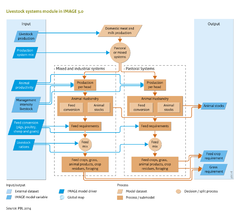Livestock systems: Difference between revisions
Jump to navigation
Jump to search
No edit summary |
No edit summary |
||
| Line 4: | Line 4: | ||
|KeyReference=Bouwman et al., 2005; | |KeyReference=Bouwman et al., 2005; | ||
|Reference=Bruinsma, 2003; Bouwman et al., 2006; Bouwman et al., 2005; Delgado et al., 1999; Seré and Steinfeld, 1996; | |Reference=Bruinsma, 2003; Bouwman et al., 2006; Bouwman et al., 2005; Delgado et al., 1999; Seré and Steinfeld, 1996; | ||
|InputVar=Production characteristics livestock; Production system mix; Feed conversion; Livestock ration; Livestock production; Management intensity livestock; Areas of regrowth forest; | |InputVar=Production characteristics livestock; Production system mix; Feed conversion; Livestock ration; Livestock production; Management intensity livestock; Areas of regrowth forest; Animal productivity; | ||
|OutputVar=Animal stock; Feed crop requirements; Grass requirement; | |OutputVar=Animal stock; Feed crop requirements; Grass requirement; | ||
|Description=Food production will have to be increased, in order to meet the increasing demand associated with adequately feeding a growing population, while the increasing prosperity and falling production costs may see a continued shifting of dietary patterns towards a larger share of meat and milk. Over the past decades, traditional, mixed farming systems have been unable to increase their production levels sufficiently to keep up with increasing demand. As a consequence, production is expanding rapidly in modern livestock production systems with larger shares of poultry and pork, creating growing demands for food crops. This trend started in high-income countries and now can be observed particularly in emerging and developing countries ([[Bruinsma, 2003]]). IMAGE describes the interactions between crop and livestock production and the consequences of changing production practices in livestock farming for food crops and grass, and the associated grassland and arable land use. For this purpose, IMAGE includes a model for pastoral livestock systems, and mixed and landless (industrial) production systems. Pastoral systems rely on grazing by ruminants, whereas mixed and landless systems have integrated crop and livestock production in which the animal rations consist of a mix of several feedstuffs, including food crops, crop by-products, grass, fodder and crop residues. The model is described in detail in [[Bouwman et al., 2005]] and [[Bouwman et al., 2006]]. | |Description=Food production will have to be increased, in order to meet the increasing demand associated with adequately feeding a growing population, while the increasing prosperity and falling production costs may see a continued shifting of dietary patterns towards a larger share of meat and milk. Over the past decades, traditional, mixed farming systems have been unable to increase their production levels sufficiently to keep up with increasing demand. As a consequence, production is expanding rapidly in modern livestock production systems with larger shares of poultry and pork, creating growing demands for food crops. This trend started in high-income countries and now can be observed particularly in emerging and developing countries ([[Bruinsma, 2003]]). IMAGE describes the interactions between crop and livestock production and the consequences of changing production practices in livestock farming for food crops and grass, and the associated grassland and arable land use. For this purpose, IMAGE includes a model for pastoral livestock systems, and mixed and landless (industrial) production systems. Pastoral systems rely on grazing by ruminants, whereas mixed and landless systems have integrated crop and livestock production in which the animal rations consist of a mix of several feedstuffs, including food crops, crop by-products, grass, fodder and crop residues. The model is described in detail in [[Bouwman et al., 2005]] and [[Bouwman et al., 2006]]. | ||
Revision as of 18:01, 30 January 2014
Parts of Livestock systems
| Component is implemented in: |
| Components: |
| Related IMAGE components |
| Projects/Applications |
|
| Models/Databases |
| Key publications |
| References |
Key policy issues
- What are the impacts of increasing livestock production on land use, greenhouse gases and other emissions to air and surface water?
- How does the use of marginal lands for grazing increase the risk of degradation and loss of productivity, inducing more forest clearing?
